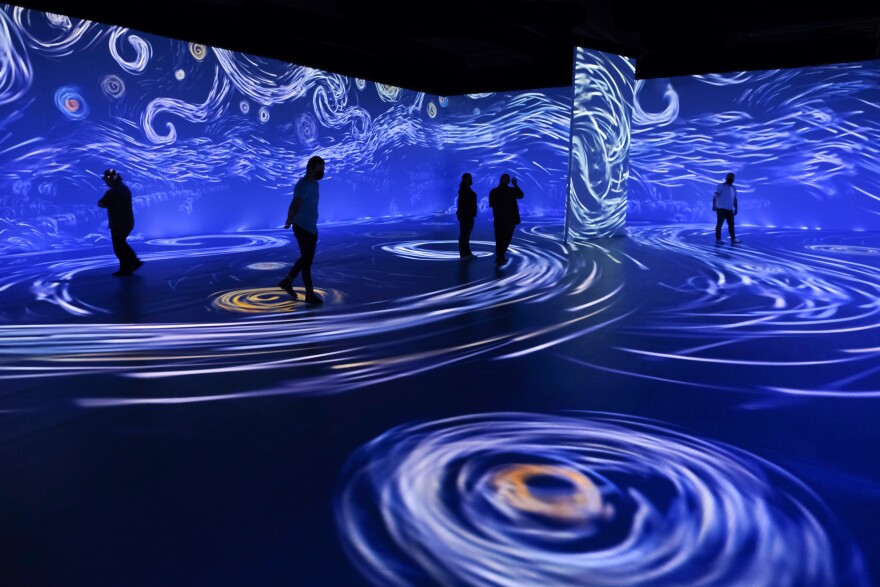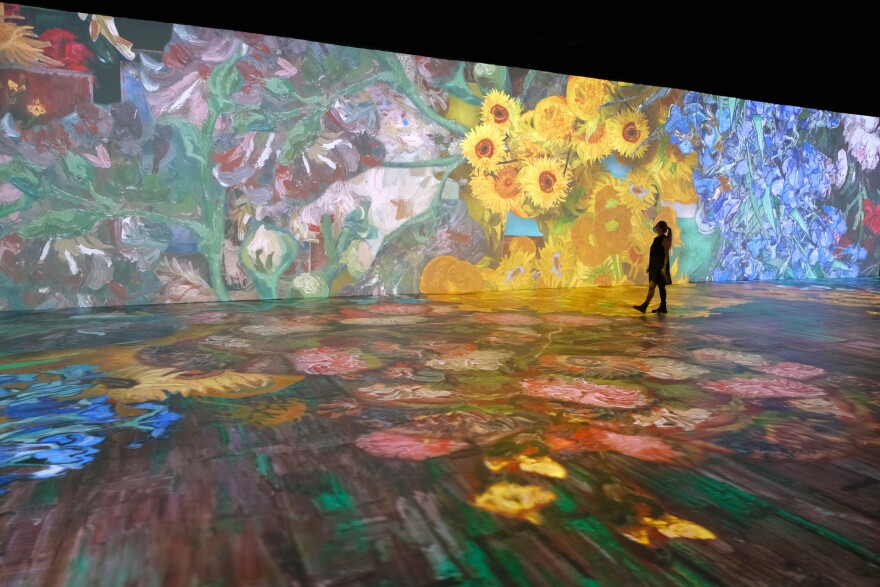To some eyes, the artist was a failure.
“He was not really very good at drawing,” says Roy Berns. “It was something that he had always wanted to improve upon, so he really worked at it. But his ability to do perspective was not that great.”
“I’m wondering if that contributed to his sort of focus on color.”
It’s often said that the artist sold only one painting in his lifetime, although that has been a slight point of contention among connoisseurs of classic canvas. Whatever the number was, it was clearly not many. Yet, he was undeterred by his failure to win widespread acclaim.
In a career that lasted just a decade, Vincent Van Gogh developed a signature style. That focus on color. Impressionist paintings in explosive colors.
Here was the big question for Berns, as he visited “Beyond Van Gogh: The Immersive Experience” last summer: Would this exhibit, housed in a giant, circus-like tent in a Buffalo mall parking lot, be a little too corny? A carnival ride through the work of one of the major artists of the 19th century?

“I was wondering if I would be kind of jaded about it,” Berns says. ‘Like, ‘Oh, you should see the real paintings, blah, blah, blah.’ But no, I thought it was a great way to have people experience his art. And maybe with the world being so internet- and animation-driven, this would draw in people. And maybe they may want to learn more about him, and see some of the actual paintings.”
Rochester’s Memorial Art Gallery has one of Van Gogh’s actual prints – an 1890 etching, “Portrait of Dr. Gachet.” But when “Beyond Van Gogh” opens Feb. 4 at the Dome Arena in Henrietta, it will be a different kind of Van Gogh experience — huge walls of projected color, with some of the works disassembled to demonstrate how the artist created them.
And with interesting, computer-generated graphics that go beyond Van Gogh. Petals fall from the flowering tree of one of his paintings.
“Beyond Van Gogh” runs through March 20 at the Dome Arena.
Berns, who lives in Pittsford, is retired from Rochester Institute of Technology, where he held a title that would stress out any business card; the Richard S. Hunter Professor of Color Science, Appearance and Technology. These days, the Pittsford resident whiles away his time on guitar. He’s played in years past with the Django Reinhardt-inspired Lumiere, and with the jazzy Steve Greene Trio. Now he’s in a country-western band, Mr. Heartache.
Berns recognizes the lesser-known, more traditional, early works of Van Gogh that are presented in “Beyond Van Gogh.” Yet he also sees the exhibit as shedding new light on the artist’s most familiar work.
“I knew ‘Starry Night’ would be kind of a big thing,” he says, “because it has so much movement in the painting.”
Indeed, Van Gogh’s best-known painting, “The Starry Night,” works perfectly in this setting. We see that movement, with huge whorls of thick brush strokes seemingly caught in the gravitational pull of the stars.
“I liked how they created all of this animation, taking the paintings apart and making them kind of 3D,” Berns says. “That kind of thing, and doing fading in and out with similar styles of work.”

“Beyond Van Gogh” demonstrates the artist’s departure from the traditional dark palette of his fellow Dutch contemporaries.
“When he moved to Paris and started hanging out with some of the impressionists, that’s where he threw away the use of black,” Berns says. “So he stopped using black, and that’s where his palette started to get so much more vibrant.”
Van Gogh used complementary colors to create mood. In the film “Lust for Life,” we see Kirk Douglas portraying Van Gogh as “a wild painter, a Pollock kind of guy,” Berns says. In truth, Van Gogh’s method was careful and deliberate.
Berns understands the importance of color. At RIT, he developed a two-colored light system for photographing paintings that would present the colors more accurately.
The larger-than-life projections of “Beyond Van Gogh” show off how thickly Van Gogh applied his paints. “Deep impasto,” as Berns calls it. These were not premium paints; the pigments were not colorfast. Van Gogh assumed that if he piled on the paint as if he were frosting a cake, the colors would last longer.
But that was not the case, Berns says. One of Van Gogh’s favorite pigments, most of which he ordered through his brother, was geranium red lake. But, “The magenta would fade, and you would be left with the blue instead,” Berns says. “So it really changed some of the color palate of what you see today.”
We know this because when a cross section of the paint is examined under a microscope, we can see how the top layer has faded.
“If his paintings hadn’t faded with some of the pigments he used,” Berns says, “it would have been so garish. You kind of wonder if, how it would have been perceived later on.”
Berns agrees that not every artist fits the “Beyond Van Gogh” format of exploding light and imagery. Norman Rockwell, no. But the paint-splash abstraction of Jackson Pollock, yes. “Deconstructing the painting to show how it’s created,” Berns says. “I can see that as an animation being really interesting.”
Strong brushwork lends itself to animation: “Beyond Monet,” a similar exploration of the French impressionist, has already opened in Toronto and will be touring the United States this year.
Some visitors to the Buffalo exhibit, Berns says, went through it like they were eating from a bag of potato chips. Others, he says, savored the experience, “really trying to soak it in.” Listening to the calming, New Age music, and getting drawn into Van Gogh’s world.
“I kept going to different parts of the space and just sitting on one of those benches,” Berns says. “And just experiencing it.”

And there is so much Van Gogh experience to be shared. Ask any artist: Choosing to live as a painter is a license for self-abuse.
Van Gogh’s life was hardly New Age calm. He went through periods of heavy drinking and psychotic episodes that resulted in him being institutionalized from time to time. He painted “The Starry Night” while in an asylum. Some modern-day psychologists have suggested Van Gogh was bipolar. He relied heavily on his brother to send him money, allowing Van Gogh to paint, paint, paint. An astonishing 2,100 works over those 10 years, including more than 860 oil paintings. Flowers, self-portraits, and trees with swirling limbs. The sun and night stars, wrapped in swirls of pigment.
Art that no one wanted at the time, a public indifference to accompany a tortured personal life that included the iconic act of using a knife to slice off one of his ears – supposedly over unrequited love.
Yet now, so many people want a piece of Van Gogh. A small planet discovered in 1989, “4457 van Gogh,” is named for the artist. Van Gogh paintings have been sold for astronomical prices. One portrait of his doctor went for $82.5 million; Alas, this more fully realized version of “Portrait of Dr. Gachet” is not the print to be found in the collection of the Memorial Art Gallery.
These different versions of “Portrait of Dr. Gachet” were done in 1890, in the last months of Van Gogh’s life.
After despondently wandering into a wheat field that he had been painting, and shooting himself in the chest, Van Gogh apparently had a change of heart. He walked back to his room, smoking his pipe while waiting for his wound to heal. That didn’t happen. He died a couple of days later from an infection. He was only 37.
Amazingly, it wasn’t until 1962, in the same kind of wheat fields that we see in “Beyond Van Gogh,” that a rusty revolver was found. A gun that would have fired the same caliber of bullet that led to the artist’s death.
So! It must have been the gun!
And three years ago, it was sold in auction for $182,000.
A dark souvenir of the artist’s death. Yet still not dark enough for some people, who have been suggesting over the years that Van Gogh was actually murdered. As if the poor guy’s legacy needed any more drama.


